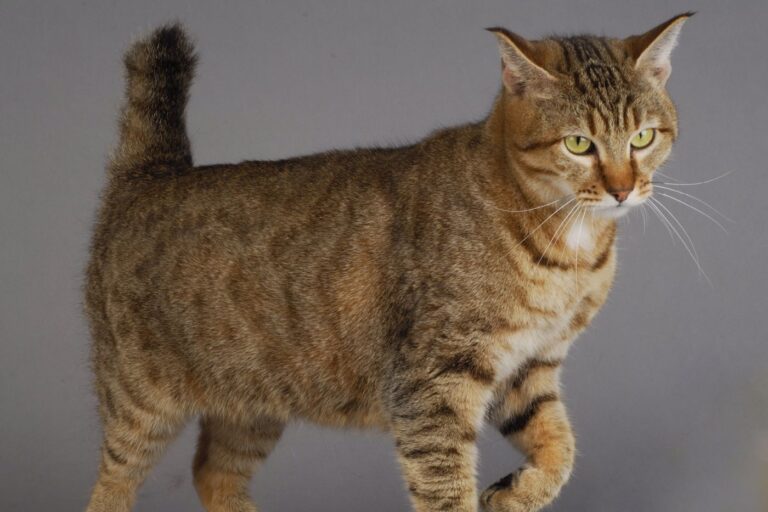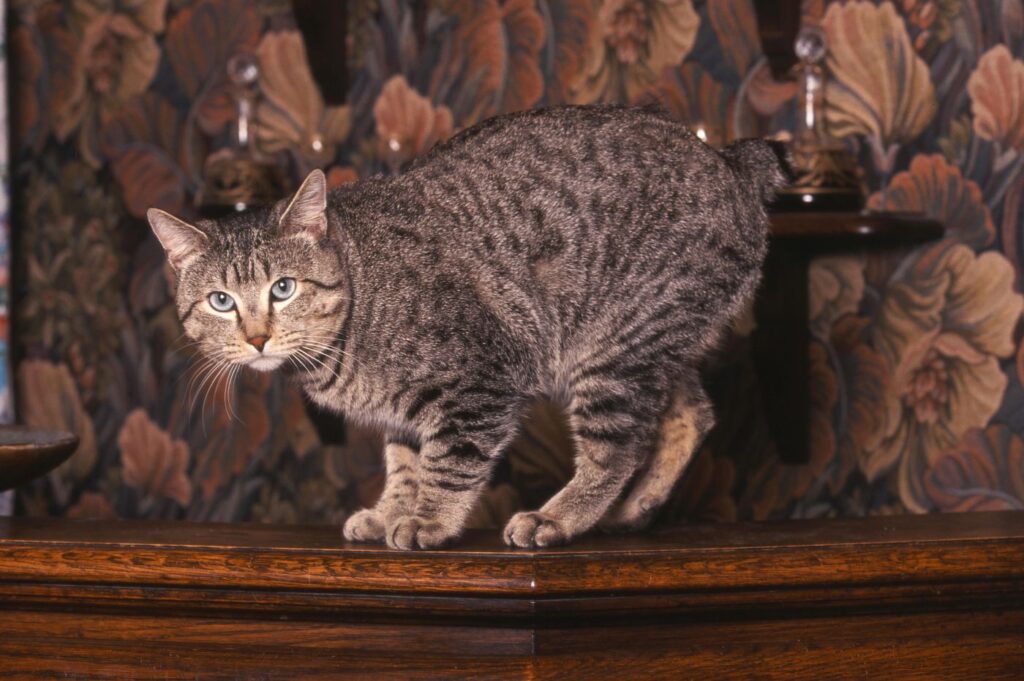Maine Coon
The Maine Coon has become one of the most popular cat breeds in the world. This is probably due to its majestic appearance, robust nature and great character.
Short tail, spotted fur, tufts of hair in the ears: the Pixiebob looks like a little lynx. But its shortened tail often causes problems in everyday cat life, which is why this breed is considered to be the result of breeding for physical traits that can cause suffering.

© coulanges / stock.adobe.com
The Pixiebob is known for its shortened tail, which can cause difficulties when communicating with other cats.
Those wondering which indoor cat resembles a lynx will quickly come across the Pixiebob when researching online. Sometimes spelled as Pixie-Bob, this breed indeed slightly resembles a lynx, especially due to its shortened tail.
Moreover, the Pixiebob, much like its wild big cat counterpart, has a stocky and muscular body. Female cats usually weigh between three and five kilograms, while male cats weigh between five and seven kilograms.
Pixiebobs typically have a greyish-brown, spotted coat. Their summer coat is somewhat shorter, making their fur patterns more distinctly visible. In contrast, their winter fur is longer, denser, and stands out more from the body.
The broad, curved head and tufted ears complete the wild look of this cat breed. The Pixiebob’s eyes are golden or green.
The paws can have a hereditary feature and be equipped with up to seven toes. Thus, the Pixie-Bob is the only cat breed where polydactyly, i.e., having additional fingers or toes, is permissible according to breed standards and tolerated.
While the Pixiebob has numerous fans due to its lynx-like appearance, this cat breed is considered problematic.
The reason for this is its stubby tail, which restricts the cat’s ability to communicate. Cats use their tails to express their mood, among other things: an erect tail with a kinked tip can signify delight or excitement, while a lowered, bushy tail is a sign of fear. The tail also plays an important role in running and climbing.
Cat breeds like the Pixiebob, which have had this essential body feature deliberately removed through selective breeding, are therefore considered breeding-for-suffering. Other short-tailed or tailless breeds also fulfil this condition, for instance, the Manx, the Cymric cat or the American Bobtail.
Despite looking like a miniature wild lynx, the Pixie-Bob is playful, sweet, and affectionate. Many animals of this breed like to cuddle with their humans and get along well with other cats, often even with dog.
Some Pixiebobs are particularly chatty and meow a lot – with some of their sounds resembling chirping, trilling or purring. Since these cats are usually very intelligent and capable of learning, their owners should challenge and encourage them with appropriate cat toys.
They can form close bonds with children, but should be given enough time to settle in.
Pixiebobs can be kept as pure indoor cats, but they enjoy time spent in a secure garden or on a netted balcony. Those unable to offer their Pixiebob outdoor access should engage with them extensively every day to keep this active cat satisfied.
Good to know: Pixie-Bobs are often very human and location-oriented. They love to follow “their” person everywhere. They tend to cope poorly with moving house.
Coat care for this breed is relatively straightforward. For the Pixie-Bob Shorthair, brushing its short coat once a week is sufficient. If the coat is long, the kitten requires a bit more care – especially in winter.
The appropriate diet for a Pixiebob varies from cat to cat and depends, among other things, on its age, activity level and any chronic illnesses.
A wide range of dry cat food can be found in the zooplus online shop.
 © CALLALLOO CANDCY / stock.adobe.com
© CALLALLOO CANDCY / stock.adobe.com
Little is known about breed-specific diseases. However, the additional toes and, most crucially, the short tail can lead to health problems: Apparently, the breeding characteristic of short-tailedness is associated with limited mobility in the cervical spine.
Furthermore, genetic diseases have been observed more frequently in the Pixiebob, including those affecting the heart muscle and the uterus. Overall, this breed seems to have a slightly increased risk of dying young.
The Pixiebob is a relatively young cat breed that originated in the USA. There, breeder Carol Ann Brewer began intentionally breeding these stubby-tailed, lynx-like domestic cats in the mid-1980s.
It was long thought that the Pixiebob was the result of a random cross between a bobcat and a domestic cat. However, this assumption has since been disproven, as DNA testing of the breed has found no traces of the American bobcat.
Closeness to other wild cats like the swamp cat or the leopard cat was also ruled out. Despite its wild look, the Pixiebob is therefore one hundred percent a domestic cat.
Incidentally, this cat breed owes its name to the cat named Pixie (translated: Faerie) from the breeding of Carol Ann Brewer, from which all Pixiebobs are descended. The name appendage “bob” comes from Bobcat, the English word for the bobcat.
Since 1998, the Pixiebob has been recognised by the [International Cat Association (Tica)] as a distinct breed.
This breed is relatively rare in this country: only a few breeders offer Pixiebob kittens for sale, as this breed is considered problematic due to its short tail. Those who wish to purchase a Pixiebob should expect to pay between 900 and 1500 euros.
However, true animal lovers should refrain from purchasing due to the breeding-for-suffering issue and opt for a different breed of cat instead. Those who still want to welcome a Pixiebob should adopt a kitten from animal rescue, to avoid supporting the breeding-for-suffering business.
The Pixiebob certainly exerts a fascination due to its lynx-like appearance. However, since this breed is considered a case of breeding-for-suffering due to its shortened tail, purchasing is not recommended.
| Feature | Description |
|---|---|
| Special Features | The Pixiebob is a lynx-like cat breed with a shortened tail that gets along well with people and animals. |
| Character | Affectionate, loving, playful |
| Weight | 3-7 kg |
| Eye Color | Gold or green |
| Colors | Grayish-brown with spots |
| Coat | Short in summer, longer in winter |
| Coat Care | Brush once a week, otherwise low maintenance |
| Life Expectancy | Approximately 10-15 years |
| Typical Diseases | Limited mobility of the cervical vertebrae, genetic diseases |
| Price | Approximately €900-1,500 |
| Origin | USA |
Here are some purchase proposals curated by the zooplus editorial team
The products featured have been carefully selected by our editorial staff and are available at the zooplus online pet shop. The selection does not constitute advertising for the mentioned brands.
The Maine Coon has become one of the most popular cat breeds in the world. This is probably due to its majestic appearance, robust nature and great character.
Large eyes and attentively upright ears instantly tell you a great deal about this charming breed of cat: Abyssinians are inquisitive and affectionate towards people.
With its long, dense fur, rounded ears, and intense stare, the Pallas Cat, or Manul, looks rather fluffy, yet somewhat dangerous. However, don't be fooled by its appearance—this is no petting zoo resident. The Manul is a wild animal and considered untameable.